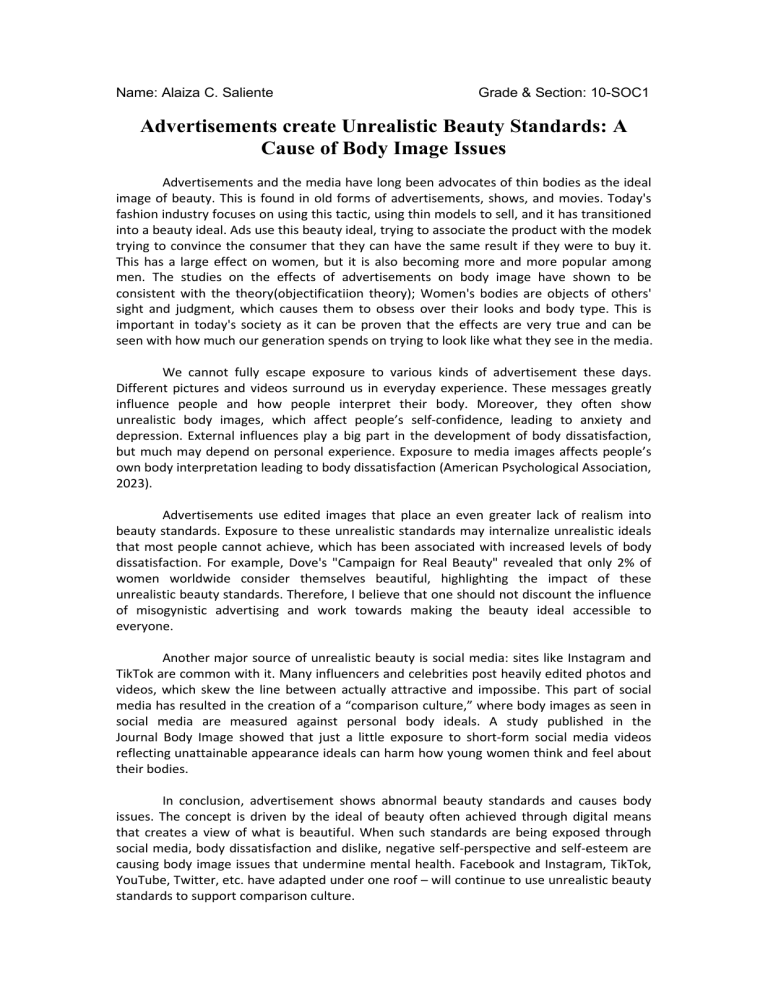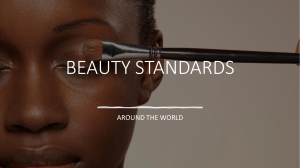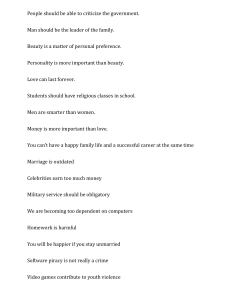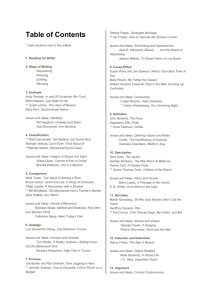
Name: Alaiza C. Saliente Grade & Section: 10-SOC1 Advertisements create Unrealistic Beauty Standards: A Cause of Body Image Issues Advertisements and the media have long been advocates of thin bodies as the ideal image of beauty. This is found in old forms of advertisements, shows, and movies. Today's fashion industry focuses on using this tactic, using thin models to sell, and it has transitioned into a beauty ideal. Ads use this beauty ideal, trying to associate the product with the modek trying to convince the consumer that they can have the same result if they were to buy it. This has a large effect on women, but it is also becoming more and more popular among men. The studies on the effects of advertisements on body image have shown to be consistent with the theory(objectificatiion theory); Women's bodies are objects of others' sight and judgment, which causes them to obsess over their looks and body type. This is important in today's society as it can be proven that the effects are very true and can be seen with how much our generation spends on trying to look like what they see in the media. We cannot fully escape exposure to various kinds of advertisement these days. Different pictures and videos surround us in everyday experience. These messages greatly influence people and how people interpret their body. Moreover, they often show unrealistic body images, which affect people’s self-confidence, leading to anxiety and depression. External influences play a big part in the development of body dissatisfaction, but much may depend on personal experience. Exposure to media images affects people’s own body interpretation leading to body dissatisfaction (American Psychological Association, 2023). Advertisements use edited images that place an even greater lack of realism into beauty standards. Exposure to these unrealistic standards may internalize unrealistic ideals that most people cannot achieve, which has been associated with increased levels of body dissatisfaction. For example, Dove's "Campaign for Real Beauty" revealed that only 2% of women worldwide consider themselves beautiful, highlighting the impact of these unrealistic beauty standards. Therefore, I believe that one should not discount the influence of misogynistic advertising and work towards making the beauty ideal accessible to everyone. Another major source of unrealistic beauty is social media: sites like Instagram and TikTok are common with it. Many influencers and celebrities post heavily edited photos and videos, which skew the line between actually attractive and impossibe. This part of social media has resulted in the creation of a “comparison culture,” where body images as seen in social media are measured against personal body ideals. A study published in the Journal Body Image showed that just a little exposure to short-form social media videos reflecting unattainable appearance ideals can harm how young women think and feel about their bodies. In conclusion, advertisement shows abnormal beauty standards and causes body issues. The concept is driven by the ideal of beauty often achieved through digital means that creates a view of what is beautiful. When such standards are being exposed through social media, body dissatisfaction and dislike, negative self-perspective and self-esteem are causing body image issues that undermine mental health. Facebook and Instagram, TikTok, YouTube, Twitter, etc. have adapted under one roof – will continue to use unrealistic beauty standards to support comparison culture. References: Shang, Y., Xie, H. D., & Yang, S. Y. (2021). The relationship between physical exercise and subjective well-being in college students: The mediating effect of body image and self-esteem. Frontiers in Psychology, 12, 658935. Rounsefell, K., Gibson, S., McLean, S., Blair, M., Molenaar, A., Brennan, L., ... & McCaffrey, T. A. (2020). Social media, body image and food choices in healthy young adults: A mixed methods systematic review. Nutrition & Dietetics, 77(1), 19-40. Leung, W. (2023). Reducing social media use improves body image in teens: study. Globe & Mail (Toronto, Canada), A16-A16. Gurtala, J. C., & Fardouly, J. (2023). Does medium matter? Investigating the impact of viewing ideal image or short-form video content on young women’s body image, mood, and self-objectification. Body Image, 46, 190-201.




